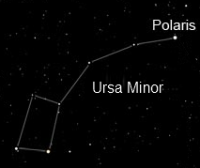Zvezdara Flag
The feature within the Zvezdara Flag that distinguishes its national identity is the cross of Serbia
Zvezdara Flag
In 1929 the head of Belgrade Astronomical Observatory, Vojislav V Miskovic, built an observatory on a hillside a few kilometres southeast of Belgrade.
Although the facility was named Zvezdara (an archaic Serbian word for 'observatory'), the institute has not restricted itself to star-gazing. It has also made important contributions to science in the fields of meteorology, seismology and geomagnetism. Their credo is Omnia in numero et mensura (All things within measure).
Their logo, shown on the left, was designed by Serbian architect and artist Ostoja Bugarski in 1987. The institute tells us that the stars on the logo have no special significance; chosen purely for aesthetic reasons.

Belgrade Astronomical Observatory

Ursa Minor is Latin for 'Little Bear'. Was this constellation chosen as a friendly dig at the Great Bear of Russia?
After the construction of the facility, the ensuing urban development assumed the same name 'Zvezdara' and it is now a suburb of Belgrade. The red, blue and white of the municipality's flag are from the Pan-Slavic tricolour of the Serbian Flag.
It is not known whether the seven stars of the observatory's logo influenced the 1993 design of the flag; the observatory's stars have five points and the municipality's emblem uses six-pointed stars. The only similarity is the number of stars used. (It is possible that either or both designers were influenced by the popularity of the number seven.)
The arrangement of the stars on the municipality's emblem will be recognised by junior astronomers as the ancient stars of Ursa Minor (also called the Little Dipper), a constellation in the northern sky.
For Zvezdara, the use of six-pointed stars on their emblem emphasizes their celestial symbolism rather than any political symbolism implied by the Socialist five-pointed star.
The brightest star of Ursa Minor is Polaris; always there in the northern night sky, marking the North Celestial Pole ('true north'). For thousands of years, this has been a navigator's benchmark, defining south, east and west. Could there possibly be any better symbol for guidance than that?
The answer of course is yes. And it is found in the Zvezdara flag, upper left corner.
Go back to the main Serbian Cross page.
For an excellent site giving more detailed information about Serbian flags, see: zastave-grbovi.com, and for flags in general, a very good flag locator is at: flagid.org


